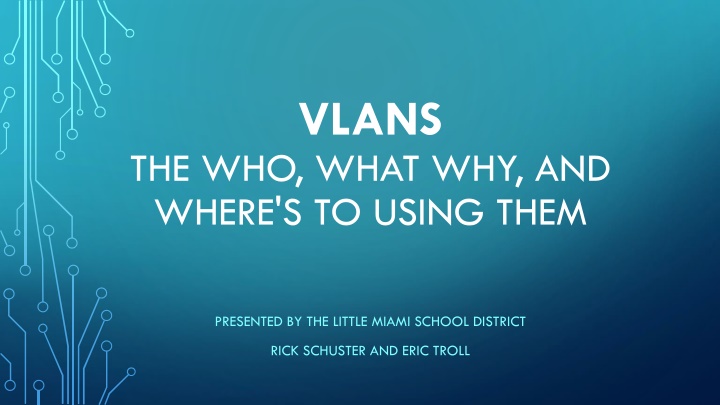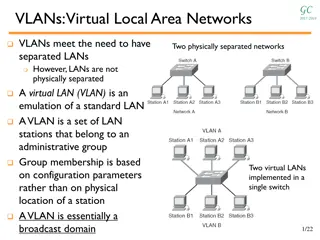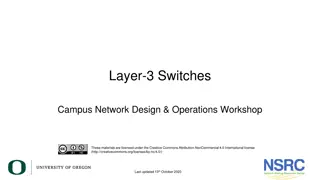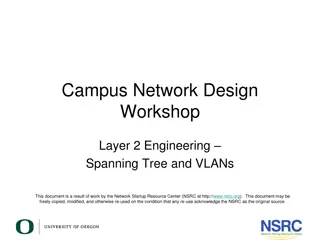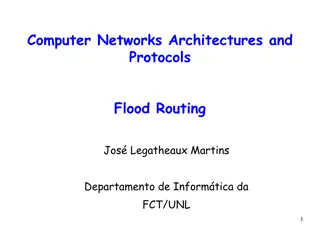VLANs - The Basics and Implementation
VLANs, or Virtual Local Area Networks, are groups of devices configured to communicate as if on the same network segment despite being on different LANs. Learn about VLAN concepts, Layer 2 and 3 functions, hardware requirements, and practical implementations for segregating network traffic efficiently.
Download Presentation

Please find below an Image/Link to download the presentation.
The content on the website is provided AS IS for your information and personal use only. It may not be sold, licensed, or shared on other websites without obtaining consent from the author.If you encounter any issues during the download, it is possible that the publisher has removed the file from their server.
You are allowed to download the files provided on this website for personal or commercial use, subject to the condition that they are used lawfully. All files are the property of their respective owners.
The content on the website is provided AS IS for your information and personal use only. It may not be sold, licensed, or shared on other websites without obtaining consent from the author.
E N D
Presentation Transcript
VLANS THE WHO, WHAT WHY, AND WHERE'S TO USING THEM PRESENTED BY THE LITTLE MIAMI SCHOOL DISTRICT RICK SCHUSTER AND ERIC TROLL
LETS HIT THE VERY BASICSWHAT IS A VLAN While most in our field know what a LAN or WAN is, you may have only heard of VLANs. Here is Cisco s description of a Virtual Local Area Network: A VLAN is a group of devices on one or more LANs that are configured to communicate as if they were attached to the same wire, when in fact they are located on a number of different LAN segments. Because VLANs are based on logical instead of physical connections, they are extremely flexible. VLANs define broadcast domains in a Layer 2 network. A broadcast domain is the set of all devices that will receive broadcast frames originating from any device within the set. Broadcast domains are typically bounded by routers because routers do not forward broadcast frames. Layer 2 switches create broadcast domains based on the configuration of the switch. Switches are multiport bridges that allow you to create multiple broadcast domains. Each broadcast domain is like a distinct virtual bridge within a switch.
SO WHAT DOES THAT REALLY MEAN? With a managed switch(layer 2) you can have several different networks connected. In the graphic you can see 4 different networks(VLAN) running from one switch. This is ideally how you would want to setup you network. This keeps traffic from your computers and cameras from interfering with your VoIP network which can phone lag or make your users sound like robots. To interconnect two different VLANs, you must use routers or Layer 3 switches. Otherwise computers and devices in different VLANs don t know how to talk to each other.
WHAT DOES LAYER 2 AND 3 MEAN? Layer 2 and 3 are part of the OSI model. This model is the standard for how networks connect and transmit data. Layer 2 is the Data Link layer. Once you plug in a computer or device to a switch port and get a link light, you have created a layer 2 connection. Layer 3 is the Network layer. Using a router or layer 3 switch, you can create routes which allow traffic to flow between VLANs.
THE HARDWARE NEEDED!! While it would be great if all hardware was able to control VLANS sadly it is not true. You will need at least a managed layer 2 switch to create VLANs. A Router or Layer 3 switch is required to route traffic from VLAN to VLAN. Small unmanaged switches like the one pictured to the left do not have the ability to create or manage VLANs. They simply pass traffic based on MAC only.
ENOUGH TALK LETS SHOW.. We will show you a live demonstration of how to: Create VLANs and VLAN interfaces on a Cisco switch. Configure ports on the switch
WHAT ELSE TO KNOW? Trunk ports: Trunk port Trunk ports allow traffic from all VLANs to flow. VTP (VLAN Trucking Protocol) Allows you to manage and automatically sync VLANs across your network by setting one switch as master and the other switches as client. This is a Cisco proprietary function. VLAN Pruning No it s not like pruning a shrub. With VLAN pruning, you can limit which VLAN traffic can travel through a trunk port. Native VLAN In some cases, like with VM hosts or wireless access points, you will want to use a trunk port. In those cases, you want your host or AP to be on a management VLAN. Setting the native VLAN ensures those devices automatically connect to that VLAN.
DHCP FOR CLIENT DEVICES There are two ways to handle DHCP once you setup your network and VLANs. Create a DHCP pool on a router or layer 3 switch. With this setup, clients will get their IP address from the router or switch. DHCP Helper If you use a server which is in a separate VLAN, you need to tell clients how to find it. By adding the ip address-helper command to each VLAN interface, clients in that VLAN can now find and get an IP address from your DHCP server. Example: ip address-helper 10.0.0.20
SPANNING TREE Spanning-Tree Protocol (STP) prevents loops from being formed when switches or bridges are interconnected via multiple paths. (Like when someone plugs both ends of a cable into the same switch) Use these settings on ports with clients devices. Port Fast This tells the switch you are only connecting client devices to a switch port. This brings a port up faster since the switch will bypass spanning tree checks. BPDU Guard Use this on the same ports configured with portfast. If BPDU packets are detected on the port, there is a network loop and the port is shutoff.
CONTACT Rick Schuster Network Manager rschuster@lmsdoh.org Eric Troll District Tech etroll@lmsdoh.org
